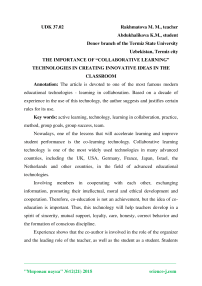The importance of “collaborative learning” technologies in creating innovative ideas in the classroom
Автор: Rakhmatova M.M., Abdukhalikova K.M.
Журнал: Мировая наука @science-j
Рубрика: Основной раздел
Статья в выпуске: 12 (21), 2018 года.
Бесплатный доступ
The article is devoted to one of the most famous modern educational technologies - learning in collaboration. Based on a decade of experience in the use of this technology, the author suggests and justifies certain rules for its use.
Active learning, technology, learning in collaboration, practice, method, group goals, group success, team
Короткий адрес: https://sciup.org/140263331
IDR: 140263331
Текст научной статьи The importance of “collaborative learning” technologies in creating innovative ideas in the classroom
Nowadays, one of the lessons that will accelerate learning and improve student performance is the co-learning technology. Collaborative learning technology is one of the most widely used technologies in many advanced countries, including the UK, USA, Germany, France, Japan, Israel, the Netherlands and other countries, in the field of advanced educational technologies.
Involving members in cooperating with each other, exchanging information, promoting their intellectual, moral and ethical development and cooperation. Therefore, co-education is not an achievement, but the idea of coeducation is important. Thus, this technology will help teachers develop in a spirit of sincerity, mutual support, loyalty, care, honesty, correct behavior and the formation of conscious discipline.
Experience shows that the co-author is involved in the role of the organizer and the leading role of the teacher, as well as the student as a student. Students should clearly organize the activities of the trainees. If a trained person does not cope with the work, then the manager or organizer is always to blame.
Methods of joint training, an unusual study of the topic between the student and the teacher ensures the active promotion of both parties in the course. The widespread use of modern pedagogical technologies creates the basis for joint, team or joint work of participants in the educational process. This process serves as an important factor in the well-being and understanding of the topic.
The orientation on joint learning is connected with the process of using interactive teaching methods based on the pedagogical technologies themselves. The emphasis on collaborative learning is that the instructor is a collection of active learners in the form of students, pupils, teachers, and students → students. Collaborative technologies include interactive teaching methods, such as working in pairs (diatoms), triple triangle, quartet and small groups.
The organization of lessons based on joint training requires the teacher to ensure that each team member responsively and actively performs the tasks separately in groups are offered. At the same time, a teacher, along with students in a lesson, requires an active professional and individual approach, as well as the principles of humanism and democracy.
In conclusion, it can be said that the organization of a lesson on cooperation technologies first of all increases the interest of pupils in classes in the classroom and, secondly, facilitates the production of subjects, concepts and subjects covering natural sciences.
Cooperative learning technologies during classes:
-
1. Instruct the reader to formulate the idea of writing a report to the teacher. Creating the ability to determine the most important, fundamental idea in the curriculum. Interest and attention. Study the active working method in the classroom. Many students will have skills for writing information. Learning the basics of teaching and learning.
-
2. Translation of students to describe the curriculum in diagrams, drawings, devils. Composing, drawing and so on, and improving writing skills. They demonstrate the ability to interpret new material in new ways.
-
3. Transfer of students to the development of various sources of information. Develop skills from one field of study to another area. In many cases, students transfer and optimize learning materials from one area to another.
-
4. Explanation of the essence of concepts, laws, formulas, making them logical. Teaching abstract information, underlying facts and rationales. Students learn to associate abstract information with specific materials and make them logical, structured.
-
5. Creation of problem situations. Creating skills to promote the hypothesis and justification for changing new information. Students demonstrate their ability to solve problems themselves and argue their arguments.
Список литературы The importance of “collaborative learning” technologies in creating innovative ideas in the classroom
- Ишмухамедов Р. Пути повышения эффективности обучения с использованием инновационных технологий. - Т., Низами, ТДУ, 2009.
- Исмоилова Н., Абдуллаева Д. «Метод прохождения обучения». (Методические указания) 2009.
- Ганиева М. Сборник педагогических технологий в кооперации малых групп.- Т. ТДИУ, Экономика. 2013.


